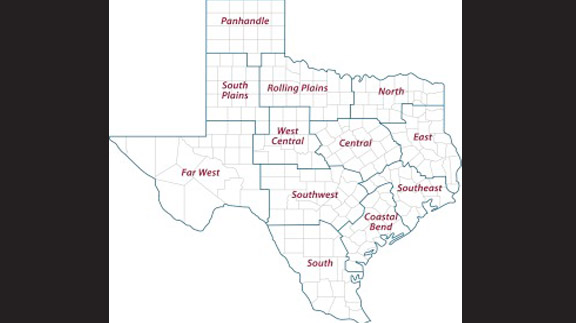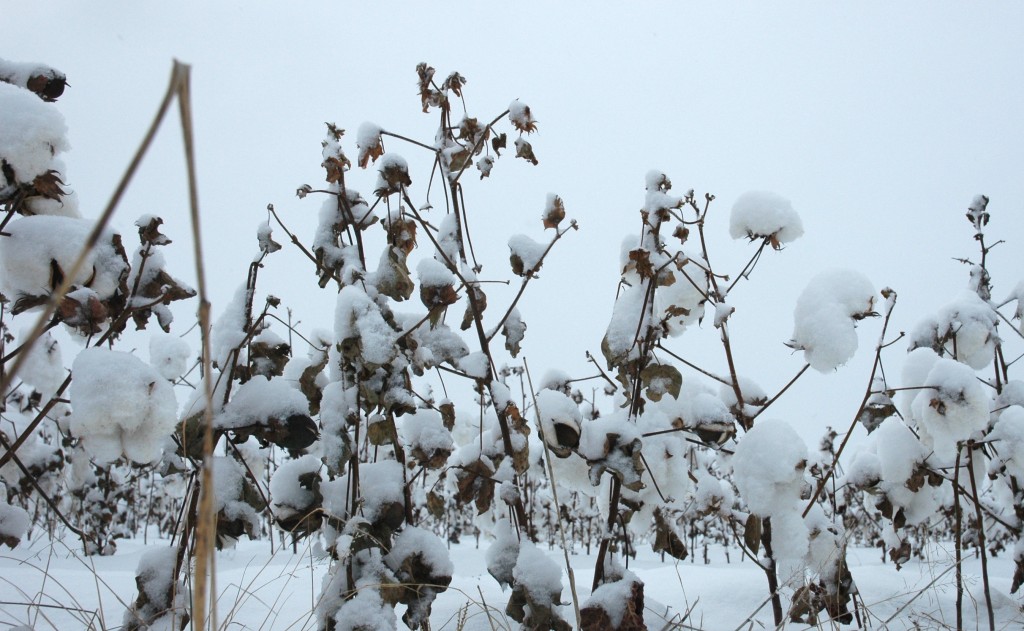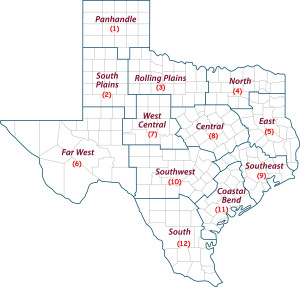Farm & Ranch
Texas, crop weather for Dec. 1,2015

By: Robert Burns
Wet freezing weather further delays cotton harvest
Writer: Robert Burns, 903-834-6191, [email protected]
COLLEGE STATION – Some farmers were concerned about the recent ice and rain in the High Plains causing deterioration of cotton grade and quality, according to Texas A&M AgriLife Extension Service reports.
However, Dr. Gaylon Morgan, AgriLife Extension state cotton specialist, College Station, said past studies have shown one such event usually does not adversely affect grade or quality to any significant degree.
Morgan cited a study done Dr. Randy Boman and Mark Kelley in 2001 that showed weathering can impact fiber quality over time.
Boman, now with Oklahoma State University, is the past regional cotton agronomist based in Lubbock. Kelley is the current program specialist for AgriLife Extension’s South Plains region.
“There’s no doubt that over time, fiber quality does decrease, but it’s a gradual process,” Morgan said. “And I don’t think the rain and ice storm is going to make a dramatic impact on fiber quality.”
Download or preview a two-minute MP3 version of this report.
“Now if we were getting into January or February, then yes, the quality does progressively go down over time. But given the storm happened at the end of November, we do not expect this one event to affect quality much.”
The intensity of such a storm can also be a factor as well, Morgan said. An extremely heavy rain can literally pull the lint off the plant.
“But it is my impression that most of this precipitation was not intense,” he said.
If several ice and rain storms follow, further delaying harvest, then over time, bark content would be expected to increase for stripper harvested cotton. Leaf grades would typically increase, while strength, length and color would diminish, which can result in substantial discounts, Morgan noted.
AgriLife Extension district reporters compiled the following summaries:
Central: Rangeland, pastures and livestock were all rated in good condition. Overall, crops were in fair condition. Soils were saturated. Temperatures remained above freezing. Stock-water tanks were full, and creeks and rivers were running. The Brazos River swelled to nearly overflowing. Producers who had earlier managed to get their wheat and oats planted had good stands, but there was concern about the future effect of standing water in fields. Livestock were holding strong. Some producers started feeding hay.
Coastal Bend: The region received more rain. Soil moisture was good, but the planting of wheat continued to be delayed by the wet conditions. Cooler temperatures and better soil moisture improved winter crops and forages in general. Cattle feeding was increased due to the cool, wet conditions.
East: Wet conditions continued throughout the region. From 2 to 4 inches of rain fell in some areas. Pasture and rangeland were in fair to very poor condition. Standing grass that had been stockpiled for winter use for beef cows was laid over and covered with water. Winter forages were getting established as warm-season forages finally entered dormancy. Topsoil moisture was adequate to surplus, while subsoil was mostly adequate. Ponds and creeks were full to overflowing. Trinity River flooding in Henderson County closed some county roads. Producers were moving cattle out of river bottoms. Feeding and working cattle was difficult due to saturated fields. Winter feeding was in full swing, with producers supplying supplements due to the poor quality of hay cut in the summer. Livestock were in fair to good condition. Fall calving was underway. Some producers in Trinity County were selling calves while others were holding them and watching the market. Polk County producers continued to market cull cows and calves with most of the bigger calves already gone. Angelina County was two weeks behind the historical average for the first frost. Feral hogs were active.
Far West: Topsoil and subsoil moisture were adequate. Glasscock County received a hard freeze that finally stopped cotton regrowth. Including moisture from melting ice, Culberson County received 0.2 inch to 1.75 inches of precipitation. Pecos County received 2.8 inches of rain. Presidio County had freezing drizzle with accumulations of 1 inch to 2 inches. Ward County received 2 to 5 inches of rain. Winkler, Loving, Reagan and Upton counties all reported up to 2 inches of rain in some places. Mule deer season began. Pasture and rangeland were in fair condition.
North: Topsoil moisture varied from adequate to surplus. On Nov. 26, a strong weather system brought much cooler air and heavy rain — from 10 to 14 inches in some areas. Temperatures remained in the 30s. Runoff created erosion problems. Winter wheat growth was stalled out by standing water. Winter pastures were doing well but needed some sunshine to help with growth. Livestock producers were providing feed and hay. Some producers were able to stockpile Bermuda grass hay to carry cows into winter a bit. Cattle were in good condition. Fall-born calves were doing well. Pastures were saturated, and feeding hay was sloppy work. Ponds and creeks were full. Timber harvesting came to a standstill. Wild hogs continued to cause damage.
Panhandle: Temperatures were slightly above average for the first part of the reporting period, then dropped to below average on Nov. 26. By that evening, a wintery mix of precipitation came to most of the region. Soil moisture continued to be rated mostly adequate. Collingsworth County received about 1 inch of ice countywide. The ice load toppled many mature trees. Harvest activities were delayed indefinitely by the wet conditions. Deaf Smith County had similar weather, and harvesting came to abrupt halt there as well. Producers had earlier wrapped up all corn and grain sorghum harvesting before the winter storm came. Yields were average to slightly below average despite all the hail and wind events of the previous two months. There were still many acres of cotton yet to be harvested, but producers were more concerned about the damage done to cotton quality than finishing the harvest. Winter wheat was in good condition, with some fields yet to be planted. Hemphill County temperatures plunged into the 20s with the coming of the light rain and snow. Ranchers were supplementing cattle with protein and hay during the stressful conditions. Wheat pasture became dormant. Ochiltree County still had a few scattered fields of corn, cotton and sorghum left to be harvested, as well as wheat to be planted. Producers were able to work only a couple of days before the freezing rain hit. Depending upon how long it takes fields to dry out, it could be a week or more before harvesting is finished. Randall County had three days of below-freezing weather. Wheeler County cotton was covered with ice.
Rolling Plains: Winter weather brought rain, sleet, ice and snow that damaged trees and downed power lines. Rain accumulations totaled more than 7 inches in some counties. The moisture was expected to boost the growth of late-planted winter wheat that had received only minimal moisture during the past few weeks. Although the moisture helped winter wheat and pastures, it wasn’t welcomed by most cotton farmers. The cotton harvest had started in many areas, but the wet conditions will keep producers out of fields for several days. However, the freezing weather was helpful. Producers who hadn’t already applied defoliants were saved the extra expense by the killing freeze. Livestock were in good condition, and producers began supplying supplemental feed daily in order to sustain cattle until wheat fields produce enough grazing. Hay supplies remained high in most areas due to almost-perfect growing conditions earlier this year. Pecans were being harvested.
South: A cold front brought cooler temperatures and drizzle but no freezing weather. Soil moisture was adequate throughout the region. In the northern part of the region, some peanut crops were harvested before rains halted fieldwork. In La Salle County, conditions were cold, rainy and misty most of the week. In the eastern part of the region, row-crop farmers sprayed weeds and grasses in fields that had sprouted after harvest. In the western part of the region, conditions remained favorable for forb and pasture growth. Winter oats were doing well with all the moisture received, and coastal Bermuda grass remained green but stopped growing due to lower temperatures. Spinach harvesting for both processed and fresh market varieties was active. Cabbage, spinach and onions made good progress. Livestock producers only had to provide minimal supplemental feed because of good grazing conditions. In the southern part of the region, fields were saturated in parts of Cameron County. Fall corn, tomatoes and onions were doing well. Harvesting these crops was expected to begin at the end of December.
South Plains: Rain and ice fell in varying amounts across the region during the Thanksgiving weekend, completely shutting down cotton harvesting. In most cases, it will be quite a while before farmers can get back into the fields to finish. In Swisher County, about 25 to 30 percent of cotton was yet to be harvested. Earlier yield reports of dryland yields ranged from 700-900 pounds per acre. Irrigated cotton averaged 1,500 pounds per acre. The winter wheat crop was shaping up to be the best in recent years due to all the early season moisture. Corn yields were between 200-240 bushels per acre. Lubbock County had temperatures near or below freezing for three days. Garza County received from 2 to 3.5 inches of rain, with temperatures dropping to the upper 20s at night. Daytime highs hovered just above freezing. Supplemental feeding of cattle during the cold weather continued. Mitchell County reported the first hard freeze of the season, finally killing the leaves of some of the confused trees and plants that had put on blooms and/or started new growth. Scurry County received from 2 to 4 inches of rain. The outlook for all other aspects of agriculture was positive.
Southeast: Soil moisture throughout the region varied widely, but was mostly adequate to surplus, with adequate ratings being the most common. Fort Bend, Lee and Walker counties had 100 percent adequate moisture. San Jacinto County had 100 surplus levels. Rangeland and pasture ratings varied from fair to poor, with fair ratings being the most common. Walker County had a few days of warm weather that promoted the growth of cool-season forages. Most ponds were filled by frequent rainfall. Rainy conditions continued in Brazos County as well. Grimes County had wet weather with intermittent cold snaps. Some pastures were too wet to work in. Montgomery County pastures were also wet, and accessing them was a problem. Fort Bend County livestock were in good condition with remaining warm-season and cool-season grasses coming on strong.
Southwest: The week was wet and cool. Rain raised topsoil and subsoil moisture levels. Pastures and winter crops were doing well. Wheat and oats improved from fair to good condition with the largely favorable weather of the past few weeks. Many warm-season plants were going dormant. Livestock remained in good condition.
West Central: Days were rainy and cold with some ice accumulations. Many areas had the first freeze. Cotton harvesting and wheat planting were halted by wet conditions. Farmers were concerned about cotton quality and grade deterioration on unharvested acres. Wheat and oats remained in good condition, but sunny weather was needed to promote growth. Rangeland and pastures continued to improve, with winter grasses emerging and greening up. Livestock were in fair to good condition with increased supplemental feeding. Stock tanks and ponds were full. Though the pecan crop was late to mature, the harvest was finally underway.
-30-
Find more stories, photos, videos and audio at http://today.agrilife.org
Farm & Ranch
Hazards of Backyard Poultry

By Barry Whitworth, DVM
Having backyard poultry is a popular agriculture enterprise. According to the United States Department of Agriculture, 0.8 percent of all households in the United States have chickens. People keep chickens for a variety of reasons with table eggs being one of the more common reasons.
Unfortunately, some of these poultry producers are not aware of the hazards that come with keeping poultry because many times they carry pathogens but appear healthy.
Chickens are carriers of several zoonotic diseases. These are diseases that can be passed from animals to humans. According to a recent survey in Pennsylvania, a majority of backyard poultry producers were aware of the dangers of avian influenza. However, this study also revealed that far fewer producers were aware of the risk of possible exposure to Salmonella and Campylobacter.
The lack of knowledge about the hazards of raising poultry likely contributes to the continued issues of Salmonella outbreaks associated with backyard poultry. In 2023, the Centers for Disease Control and Prevention reported 1,072 illnesses of Salmonella linked to backyard poultry, and 272 of those patients required hospitalization. Oklahoma reported 43 individuals with the disease.
To read more, pick up a copy of the April issue of NTFR magazine. To subscribe by mail, call 940-872-5922.
Farm & Ranch
Ag Elsewhere: Wyoming

By Tressa Lawrence
Babies are tucked away in every nook and cranny. Many ranchers across Wyoming have baby animals popping up all over this time of year.
Farm & Ranch
Ag Elsewhere: Montana

By Lindsey Monk
Another load of grain in to keep feeding the calves until the green grass can really start popping.
-

 Country Lifestyles1 year ago
Country Lifestyles1 year agoScott & Stacey Schumacher: A Growth Mindset
-

 Equine7 months ago
Equine7 months agoThe Will to Win
-

 Country Lifestyles7 years ago
Country Lifestyles7 years agoStyle Your Profile – What your style cowboy hat says about you and new trends in 2017
-

 Country Lifestyles4 years ago
Country Lifestyles4 years agoAmber Crawford, Breakaway Roper
-

 HOME7 years ago
HOME7 years agoGrazing North Texas – Wilman Lovegrass
-

 Country Lifestyles7 years ago
Country Lifestyles7 years agoDecember 2016 Profile, Rusty Riddle – The Riddle Way
-

 Country Lifestyles8 years ago
Country Lifestyles8 years agoJune 2016 Profile – The man behind the mic: Bob Tallman
-

 Outdoor9 years ago
Outdoor9 years agoButtercup or Primrose?








